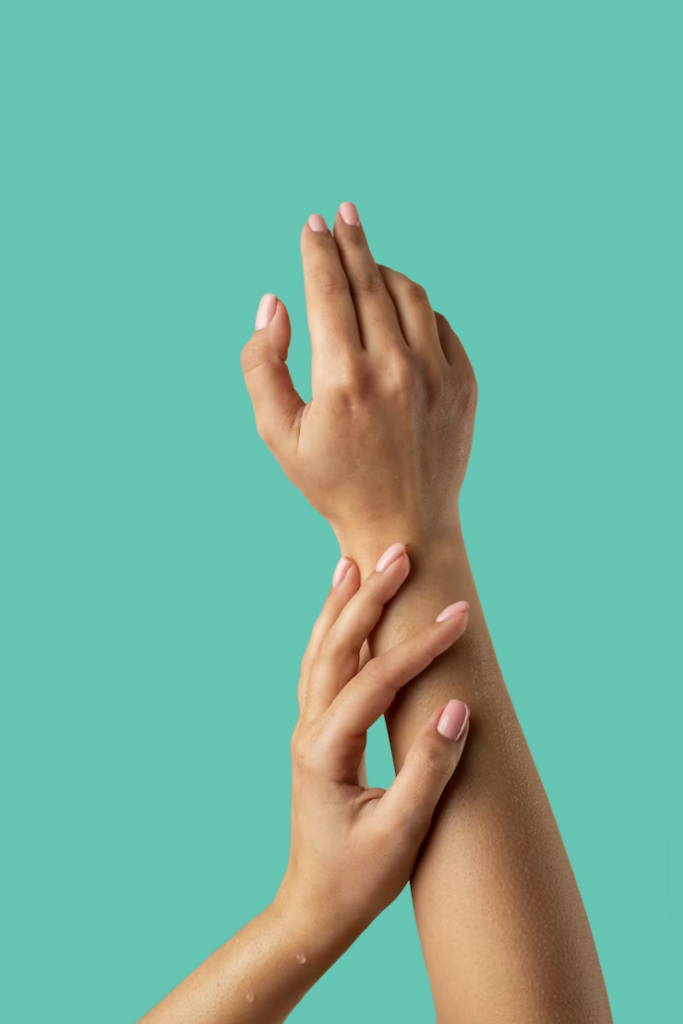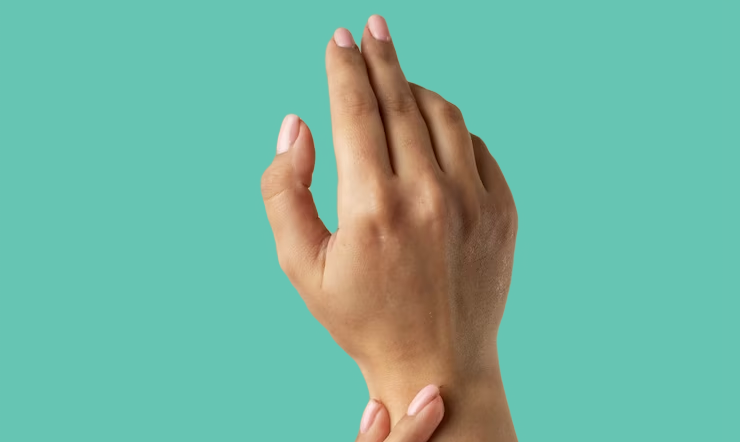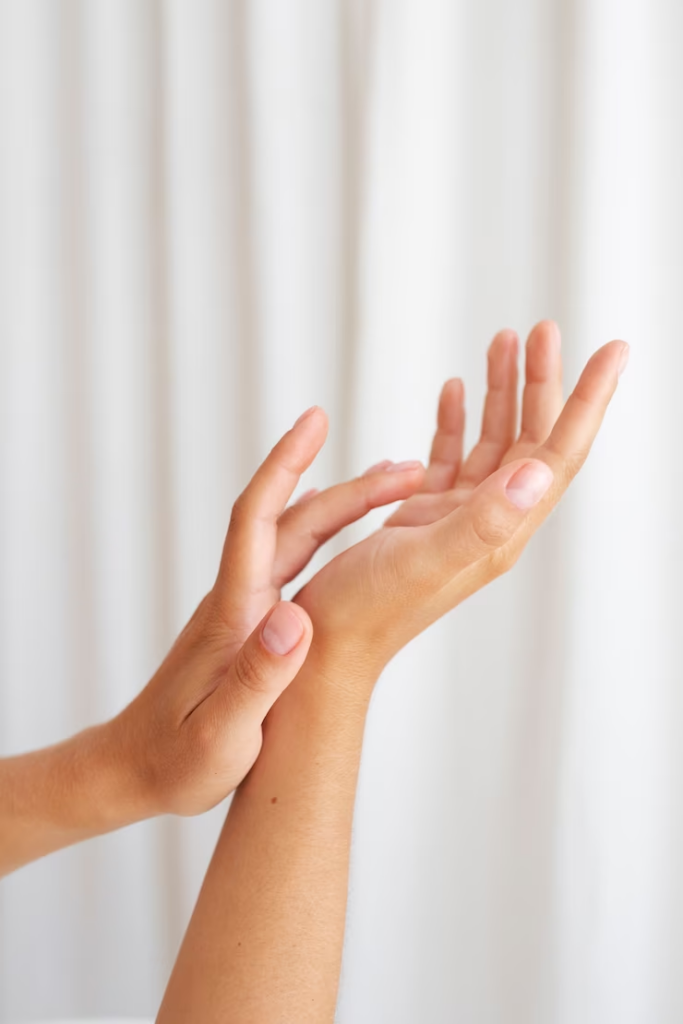- Call us
- 08.00 – 10.00
- Hitta hitt
- Personal
Carpal tunnel syndrome occurs due to pressure on one of the nerves that runs on the front of the wrist. The pressure on the nerve can be caused by swelling that occurs, for example, during overexertion or pregnancy. Often the cause is unknown, but there is a higher risk for diabetics to be affected. The symptoms of carpal tunnel syndrome are numbness, reduced sensation and sometimes pain and weakness in the thumb, index finger and middle finger. The symptoms are often provoked by strain or static work, but it is common with increased numbness at night.
Carpal tunnel syndrome is primarily treated with a wrist orthosis, a support with a splint that keeps the wrist straight at night. Sometimes the symptoms are also relieved by anti-inflammatory medicine. You can also get advice on ergonomics from a physiotherapist or occupational therapist if you use your hands a lot in your work. Sometimes a nerve conduction study is done to confirm the diagnosis.
In carpal tunnel surgery, an incision is made through the adjacent structures to make room for the nerve. The skin incision is about 5 cm long on the front of the wrist.
Information about preparations for the operation will be sent to you when you register for the operation, but you can also find parts of this information on the website.
The day of surgery at Huddinge Orthopedics begins with an enrollment call and you are prepared for surgery. The operator talks to you before the operation and you receive pain-relieving medicine and preventive medicine against nausea. The operation takes place under local anesthesia and takes about 10-20 minutes. Waiting time may occur on the day of surgery.
You can go home about 1 hour after the operation. For optimal pain relief, you will receive the prescriptions you need before going home. The surgical wound is surrounded by a bandage that reduces bleeding and prevents movement of the wrist. Stitch removal which takes place at Huddinge orthopedics 14 days after the operation. Cover the dressing when showering, for example with a plastic bag and rubber band. Avoid bathing until the sores are completely healed. The length of sick leave varies depending on your job, but is most commonly 2-6 weeks. You must not lift heavy for the first four weeks. It is important that you move your shoulder, elbow and fingers as much as the pain allows. It takes a long time for the nerve to recover, which is why it is common to have residual discomfort for the first time after the operation.


Dupuytren's contracture (crooked fingers) involves a gradual shrinking of the large tendon in the palm. Initially, the tendon becomes thicker and forms irregularities in the palm, this can lead to tenderness. After that, the tendon shrinks and forms tight strings from the palm out into the fingers, which gradually leads to the fact that the fingers cannot be fully extended. Dupuytren's contracture can affect one or both hands, and the ring and little fingers are most commonly affected. Dupuytren's contracture occurs more often in men and the disease is partly hereditary. Diabetics are affected somewhat more often than others. The indications for treatment are when at least one finger lacks more than 40° of the ability to stretch. If the treatment is carried out at too early a stage, there is a high risk of relapse.
There are two different ways to treat Dupuytren's contracture – Needle fasciotomy or surgery. Needle Fasciotomy involves injecting NEEDLES that dissolve the tight strings. Directly after the injection, the finger(s) are stretched out under local anaesthetic. During surgery, the tight string is removed through an incision in the palm. The operation is performed under general anesthesia and takes about 45-90 minutes.
After the treatment, a substantial bandage is applied and you must keep your hand still and preferably in an elevated position. Sometimes the skin can crack in connection with the stretching. The wound heals in a couple of weeks but requires dressings by a nurse in the meantime.
In case of an operation, you can go home after a couple of hours. The surgical wound is surrounded by a bandage, which is removed when you return to the occupational therapist after a couple of days, when you will receive a splint and exercise instructions. The stitch removal takes place 14 days after the operation.
Regardless of the type of treatment, it is important to cover the dressing when you shower, for example with a plastic bag and rubber band. Avoid bathing until the sores are completely healed. The length of the sick leave varies depending on the job you have.
Will I be in pain after the operation?
Usually it is enough to take Paracetamol for the pain, if necessary the doctor writes a prescription for other painkillers. After injection treatment, there is often a swelling and a feeling of tension in the hand that can extend up the arm to the armpit.
How well will I feel after the treatment?
Whether the fingers become completely straight or not depends on the degree of movement restriction and joint stiffness. It is not uncommon for a slight bending position to remain, but it usually does not cause any problems. About 30% of those affected slowly regain their symptoms after treatment, regardless of injection or surgery.


Trigger finger is caused by one of the flexor tendons of the fingers getting stuck in its own tendon sheath due to swelling. The most common symptom is that the finger gets stuck in a bent position and has to be helped free with the other hand to be stretched, which can cause pain. The swelling of the tendon can be caused by overexertion, but trigger finger can also occur without a clear explanation. The problems can be treated with anti-inflammatory medicine or cortisone injection, but in the absence of relief, surgery may be necessary.
Information about preparations for the operation will be sent to you when you register for the operation, but you can also find parts of this information on the website.
The day of surgery at Huddinge Orthopedics begins with an enrollment call and you are prepared for surgery. The operator talks to you before the operation and you receive pain-relieving medicine and preventive medicine against nausea. The operation takes place under local anesthesia and takes about 8-15 minutes. Waiting time may occur on the day of surgery.
You can go home about 1 hour after the operation. For optimal pain relief, you will receive the prescriptions you need before going home. The surgical wound is surrounded by two dressings – an outer one that reduces bleeding and prevents movement of the finger and an inner one that protects the wound. The outer dressing is removed after two days, the inner one should remain until the stitches are removed, which takes place at Huddinge Orthopedics 14 days after the operation. Cover the dressing when showering, for example with a plastic bag and rubber band. Avoid bathing until the sores are completely healed. The length of the sick leave varies depending on the job you have. You must not lift heavy for the first four weeks. It is important that you move your shoulders and elbows as much as the pain allows.
De Quervain's disease is caused by swelling around two of the thumb muscle tendons that run on the outside of the wrist. It is common in parents of small children who carry their child for long periods of time, but the problems can also arise from other stress on the wrist and thumb. The symptoms of De Quervain's disease are tenderness over the tendons and pain when bending sideways towards the side of the little finger. The treatment primarily consists of anti-inflammatory medication, cortisone injection and relieving support splint. Avoid moments that aggravate the symptoms. If the above treatment fails, surgery can be performed. The operation involves splitting the tendon compartment that surrounds the tendons.
Information about preparations for the operation will be sent to you when you register for the operation, but you can also find parts of this information on the website.
The day of surgery at Huddinge Orthopedics begins with an enrollment call and you are prepared for surgery. The operator will talk to you before the operation. The operation takes place under local anesthesia and takes about 30 minutes. Waiting time may occur on the day of surgery.
You can go home a couple of hours after the operation. For optimal pain relief, you will receive the prescriptions you need before going home. The surgical wound is surrounded by an outer dressing and an inner dressing. You can take off the outside after two days, but the inside must remain until the stitch removal, which takes place at Huddinge Orthopedics 14 days after the operation. Cover the dressing when showering, for example with a plastic bag and rubber band. Avoid bathing until the sores are completely healed. Please keep your hand elevated to reduce swelling. It is important to move the fingers and the shoulder as much as the pain allows. The length of sick leave varies depending on your job, but is most commonly 2-4 weeks. You must not lift heavy for the first four weeks.